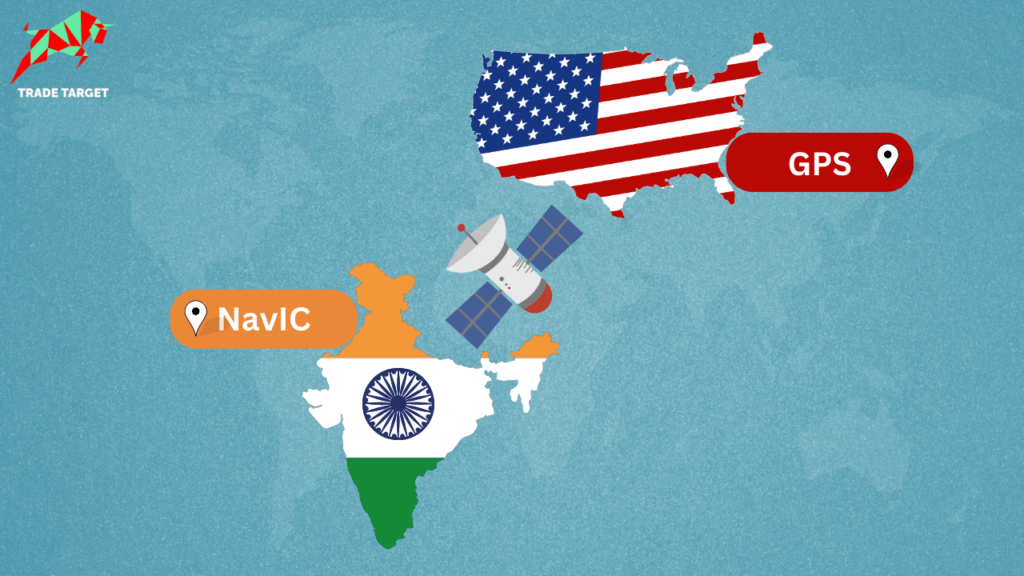Subscribe for real-time financial insights on Trade Target’s WhatsApp Channels
Before the GPS era, people had some interesting ways to find their way around. They used physical maps to plan routes, relied on compasses, and followed road signs for directions. Travelers often asked locals for advice, and they used landmarks, both natural and man-made, to navigate. Before GPS, it was harder to reach specific destinations or follow exact routes using these methods.
Nowadays, we are fortunate to have the accuracy of GPS technology to guide us seamlessly.
Have you ever thought about how easy it is to find your way to a new restaurant, avoid traffic, or even track your morning run using your smartphone? Using self-driving cars or many technologies available at our fingertips. How?
It’s all thanks to a powerful technology called the Global Positioning System, or GPS for short. This system relies on satellites in space to provide accurate time and location information to your devices. GPS has become so ingrained in our lives that it’s hard to imagine a world without it.
GPS has become super important in our lives. We rely on it in our cars, boats, planes, construction machines, farming equipment, computers, and, of course, our smartphones. But where did GPS start, and who came up with it? Let’s break it down.
First of all, there’s a bit of a debate about who should get credit for creating GPS. At least four different people played important roles in developing this amazing technology, which was originally made by the US Department of Defense to help the military.
So, who are these key people? Let’s find out!
Roger L. Easton, Ivan Getting, Bradford Parkinson, Dr. Gladys West
These people are the ones we should thank for GPS!
The Story of GPS: How It Started and Took Off
Way back in 1957, far away in Russia, something extraordinary happened. They sent a satellite named “Sputnik” into space, and it became the very first one to travel all the way around our Earth. While in orbit, “Sputnik” transmitted radio signals.
Meanwhile, some very intelligent scientists were paying close attention. They noticed something quite fascinating about these radio signals. When Sputnik got closer to them, the signals sounded like a high-pitched song. But as it moved further away, the song became deeper, like a low hum.
These scientists were so excited because they realized they could use this “sound trick” to figure out exactly where Sputnik was in space just by listening to its radio signals from down on Earth.
But these scientists didn’t stop there. They had an even more brilliant idea! If they could figure out where a satellite was by listening to its signals, they could also figure out where a special device on the ground was by measuring how far it was from the satellite. This meant they could track all sorts of things right here on our own planet!
This was the start of GPS, a system that helps us find our way, discover new places, and explore the world around us.
In the early 1960s, a new idea was born in the United States. They wanted to use special satellites to help submarines that carried powerful missiles. These satellites could figure out exactly where the submarines were in just a few minutes. It worked really well!
Then, in 1973, a group of people from the Air Force and Navy decided to make a whole system using this satellite idea. They spent three years testing and trying out their plan.
In 1979, the decision was made to increase the total number of satellites to 24. Between 1978 and 1985, eleven satellites were successfully sent into orbit and accurately positioned. These satellites had special sensors designed to detect significant explosions, such as atomic bombs.
Decoding RBI’s Unsecured Lending Norms: Impact on Loan Rates, Credit Card Firms
Expanding GPS: From Military to Civilian
In 1983, President Ronald Reagan said regular businesses, like airlines, could use this system called GPS (named Navstar). It was meant to make air travel safer and help planes find their way better. This was the first time non-military companies could use GPS.
However, the government got worried that people who weren’t on their side might use GPS against them. So, they decided to make the GPS system less accurate for regular use (they called it “selective availability”) to try to stop enemies from using it.
Since 1995, GPS technology has come a long way. It has become much better and more helpful for all of us. In the past, GPS could only find something within 100 meters, but now accuracy improved to finding subjects within 10-15 meters. This improvement happened because more satellites were sent into space.
People like us started using GPS in our daily lives. In 1999, a company called Benefon made a phone called the Benefon Esc!, and it was one of the first phones to have GPS in it. This was a big deal because it led to more phones with GPS. GPS also started showing up in cars, making it easier for us to figure out where we’re going.
But in 2000, the government decided to make GPS better and more accurate for everyone, not just the military. They even added 3 new signals to make it even better. So, overnight, GPS became 10 times more accurate for all of us to use.
President Bill Clinton made this decision to share GPS with people all over the world for everyday things and business, not just the military. This was a big step forward!
“You might be wondering about India’s contribution to the invention of GPS. Now, we will delve into India’s achievements in the realm of GPS technology. Please stay with us as we uncover the journey of Indian GPS.”
In 2014, India launched ‘Make in India‘ to showcase its potential as a manufacturing hub. The goal was to support innovators and entrepreneurs. However, the COVID-19 pandemic brought unexpected challenges, leading to an economic slowdown. On May 12, 2020, Prime Minister Modi introduced ‘Atma Nirbhar Bharat‘ or ‘Self-reliant India’. This initiative aimed to address not only the pandemic but also India’s dependence on other countries for certain goods, emphasizing self-sufficiency.
The Need for Indian GPS
Before we answer your question, let’s first understand the background of Indian GPS. Did you know that there came a moment when we realized India needed its own GPS system?
When a powerful global ally abandons you in your time of need, what do you do? You take matters into your own hands. So, about two decades ago, India decided to become Atma Nirbhar. They understood that they needed their own satellite navigation system. This was not a new idea, but the Kargil incident made it clear that it was necessary.
In 1999, when Pakistani troops seized positions in Kargil, the Indian military urgently required global positioning system (GPS) data for the region. The navigation system in space that is managed by the US government could have given important information, but the US chose not to share it with India.
It was the first time that India realized that we must have its own GPS, and the seeds were planted for “Atma Nirbhar Bharat.”
Back in 2006, with aspirations of achieving self-sufficiency in navigation and challenging the existing Western GPS system, the Indian Space Research Organisation (ISRO) embarked on the development of NavIC (Navigation with Indian Constellation), India’s own GPS. Initially expected to be completed by 2011, but only become fully operational in 2018.
But What is NavIC? Let’s Understand This First
NavIC, an independent and self-reliant navigation satellite system, was developed by ISRO and became operational in 2018. With 7 satellites covering the entire Indian landmass and extending up to 1,500 km from the international boundaries, NavIC covers India, the Indian Ocean, parts of South and Southeast Asia, and the Middle East. It aims to reduce dependency on foreign satellite systems, especially for strategic sectors. Currently, NavIC fulfills various functions, including tracking public vehicles, issuing emergency warnings for deep-sea fishermen, and providing crucial information during natural disasters.
With NavIC, India joins a group of countries that have their own positioning system with 7 satellites. Other countries with their own independent navigation satellite systems include Russia (GLONASS) with 24 satellites, the European Union (Galileo), China (BeiDou Navigation Satellite System) with 44 satellites, and Japan (QZSS) with 4.
If ISRO could send more satellites into a special orbit called the Medium Earth Orbit, or MEO. This move would allow NavIC satellites to work all around the world, just like the GPS system does.
Is NavIC better than GPS?

Currently, there is a publicly accessible unencrypted system with a range of 10 to 5 meters serving civilians. In contrast, a secure encrypted system, known as the Restrictive Service (RS), operates with a signal range of 0.1 meters and is exclusively intended for authorized users, including the armed forces, ISRO, and DRDO.
While the accuracy of the S-band and L-band may not be critical for individual users, it holds importance for military purposes.
Therefore, introducing the L-1 band to the new satellite would expand NavIC’s accessibility to the general public.
What government is planning with NavIC?
With this initiative, the Indian government has set forth a groundbreaking plan: by 2025, all mobile devices will be mandated to support NavIC (Navigation with Indian Constellation). In the Government Vision, every 5G phone must incorporate NavIC support by January 1, 2025, with all other phones required to do so by December of the same year.
This important decision is in perfect alignment with India’s commitment to achieving self-reliance in technology. Additionally, the government has outlined plans to provide incentives for the manufacturing of NavIC-powered chips as part of system design. The government has expressed a clear intention to gradually make it mandatory for all devices to incorporate NavIC chipsets.
Recently, Apple has made a big step in supporting India’s own navigation system, called NavIC, in their latest iPhone 15 series. This is special because these iPhones are the first ones made in India that can use NavIC. This shows that Apple is really committed to helping India in its tech progress, and it is setting an example for other phone companies to do the same. By 2025, the Indian government wants all big phone makers to use NavIC in their devices. Apart from the iPhone, various Chinese brands have already begun incorporating NavIC technology into some of their smartphone models, signaling a growing trend in the industry.
A big company called Qualcomm from the US has also been a fan of NavIC since 2019. They put it in some of their special chips for phones after Qualcomm and ISRO signed an agreement that made NavIC even more trustworthy and reliable. This move means that NavIC will now compete with other well-known navigation systems like the US’s GPS, the EU’s Galileo, Russia’s GLONASS, and China’s BeiDou.
Conclusion
In conclusion, ndia is actively promoting the integration of NavIC-supported processors in smartphones, with the goal of encouraging the widespread adoption of this technology among manufacturers. However, this move may lead to potential alterations at the chipset and hardware levels, which could result in a slight increase in phone prices.
Happy investing and thank you for reading!
Disclaimer: This website content is only for educational purposes, not investment advice. Before making any investment, it’s important to do your own research and be fully informed. Investing in the stock market includes risks, and you should carefully read the Risk Disclosure documents before proceeding. Please remember that past performance doesn’t guarantee future results, and due to market fluctuations, your investment goals may not always be achieved.
Share via:




